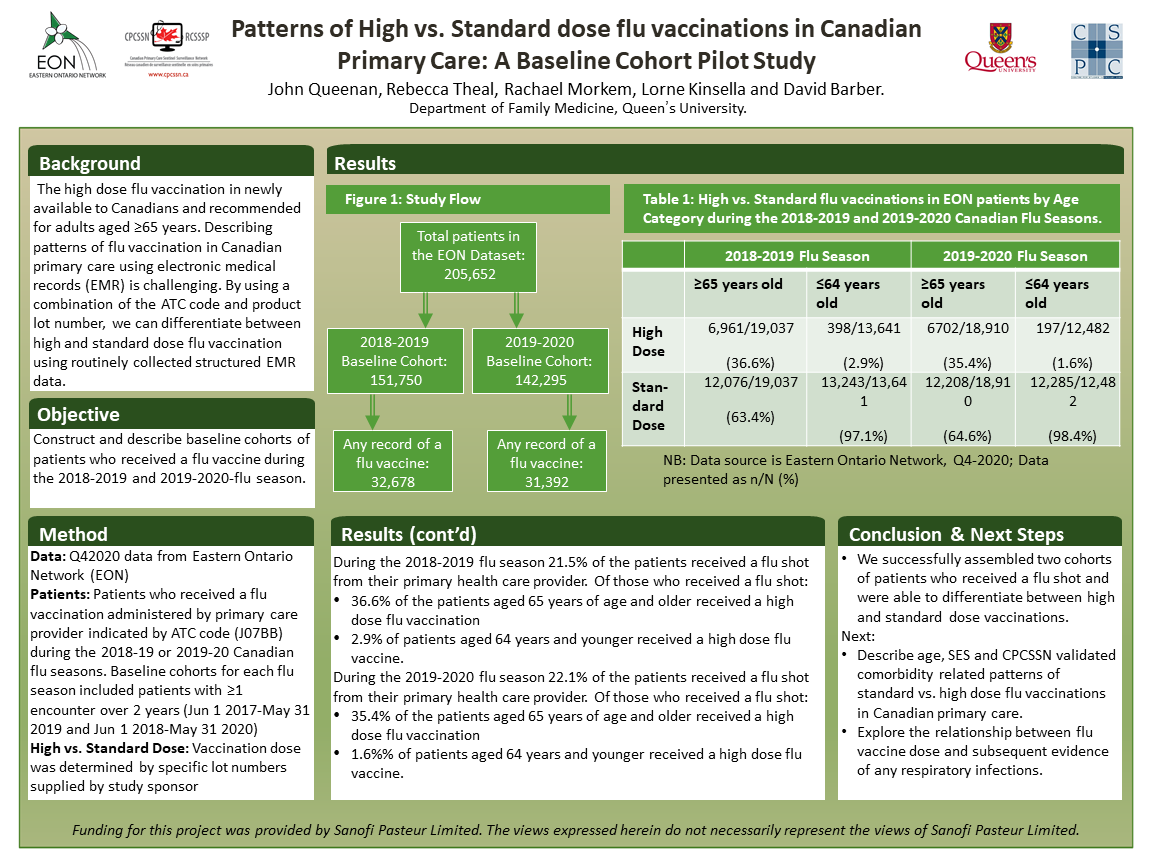PRP062: Patterns of High vs. Standard dose flu vaccinations in Canadian Primary Care: A Baseline Cohort Pilot Study
Rebecca Theal; Rachael Morkem, MSc; John Queenan, PhD, BA, MSc; David Barber, MD, BSc
Abstract
Context: Canadian vaccination guidelines recommend that all Canadians, with few exceptions, aged 6 months of age and older be vaccinated. All age groups are eligible to receive a range of standard dose vaccinations. Only adults aged 65 years of age and older are recommended to receive a high dose flu vaccination, a relatively new product available to Canadians. Describing patterns of flu vaccination in Canadian primary care using electronic medical records (EMR) is challenging. The product Drug Identification Number is not always recorded and the Anatomical Therapeutic Chemical (ATC) Classification System code for flu vaccine is rather general: J07BB does not differentiate between high and standard dose products. However, we have established that by using a combination of the ATC code and the lot number of the product administered we can differentiate between high and standard dose flu vaccination using routinely collected structured EMR data. Objectives: 1) Construct a baseline cohort of patients who received a flu vaccine during the 2018-2019 and 2019-2020 flu seasons. 2) Describe age, SES and comorbidity related patterns of standard vs. high dose flu vaccinations in Canadian primary care. 3) Explore the relationship between flu vaccine dose and subsequent evidence of any respiratory infections. Study Design: Baseline cohort pilot study. Dataset: The Canadian Primary Care Sentinel Surveillance Network (CPCSSN), a repository of clinical EMR data drawn from primary care networks across Canada. Population Studied: Patients who received a flu vaccine within a primary care setting during the 2018-2019 and/or 2019-2020 flu seasons (June 1 2018-May 31 2020). Outcome Measures: Flu vaccinations are determined by ATC code (J07BB). All patients who have been vaccinated with a high dose lot number product are classified as “high dose”, all others are classified as “standard dose”. Subsequent respiratory infections will be classified by available ICD9 codes. Results: A baseline cohort of patients who received a flu vaccine during the 2018-2019 and 2019-2020 flu seasons will be reported. Frequency counts of high vs. standard dose flu vaccinations will be stratified by sex, age, SES, and CPCSSN validated chronic health conditions. Patterns of subsequent respiratory infections stratified by flu vaccine dose (standard vs. high) will be described. Funded by Sanofi.

Diane Harper
harperdi@med.umich.edu 11/21/2021Good example of a phase IV study. Do you have a larger group to collaborate with for more robust results? Thank you for sharing with us at NAPCRG.